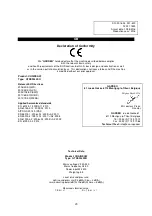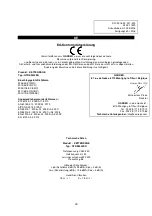
36
TENSIONING THE SAW CHAIN
Always pull the plug out of
the power socket before
doing any work on the
chainsaw!
Wear safety gloves!
Turn the outer Knob clockwise until the saw chain is
correctly tensioned, then rotate the inside knob (5)
to block the guide bar in that position.
While the inside knob is being tightened, the guide
bar must then be pushed upwards.
Check the chain tension again (see Fig. 3). Do not
tension the chain too tightly.
When cold, it should be possible to lift the chain in
the middle of the guide bar approx. 5 mm. Tighten
the lock nut (5) securely.
When warm, the saw chain will expand and slacken
and there is a danger of it jumping off the rail
altogether. Re-tension if necessary.
If the saw chain is re-tensioned when hot, it must be
loosened again when the sawing work has been
completed. Otherwise, the contraction which takes
place as the chain cools would result in excessively
high tension.
A new saw chain requires a running-in period of
approx .5 minutes. Chain lubrication is very
important at this stage. After running in, check chain
tension and re-tension if necessary.
Before checking and
adjusting the chain tension,
never forget to unplug the
tool.
FILLING IN CHAIN OIL
To prevent dirt getting inside the tank, clean the oil
tank cap (21) before opening. Check the contents of
the oil tank during sawing work by checking the oil
gauge (15). Close the oil tank cap tightly and wipe
away any spills.
SECURING THE EXTENSION LEAD
Only use extension leads suitable for outdoor use.
The cross section of the cable (max. length of
extension cord: 75m) must be at least 1,5 mm².
secure the chainsaw flex to the extension lead by
inserting the extension lead into the strain relief gap
of the housing.
Extension leads longer than 30 m will reduce the
performance of the chainsaw.
CHAIN LUBRICATION
To prevent excessive wear, the saw chain and
guide bar must be evenly lubricated during
operation.
Lubrication is automatic. Never work without chain
lubrication. If the chain runs dry, the entire cutting
apparatus will quickly become severely damaged. It
is therefore important to check both chain lubrication
and the oil gauge every use (Fig. 4).
Never use the saw when the oil level is below the
“Min.” mark.
Min.:
When only approx. 5 mm of oil is
visible at the lower rim of the oil gauge
(15), you must top up with oil.
Max.:
Top up with oil until the window is
full.
CHECKING THE AUTOMATIC
LUBRICATION
Before commencing work, check the automatic
chain lubrication and oil gauge. Switch on the chain
saw and hold it above the ground. Be careful not to
allow the chain saw to touch the ground. For safety
reasons it is best to keep a clearance of at least 20
cm. If you now see growing traces of oil, the chain
lubrication system is working correctly. if there are
no traces of oil at all, try cleaning the oil outlet, the
upper chain tensioning borehole and the oil duct, or
contact your Customer Service.
CHAIN LUBRICANTS
The service life of saw chains and guide bars
depends to a large extent on the quality of the
lubricant used. Old oil must not be used! Use only
environment-friendly chain lubricant. Store chain
lubricant only in containers which comply with the
regulations.
GUIDE BAR
The guide bar (7) is subjected to especially severe
wear and tear at the nose and the bottom. To avoid
one-sided wear and tear, turn the guide bar over
every time when you sharpen the chain.
CHAIN WHEEL
The chain wheel (16) is subjected to especially high
wear and tear. If you notice deep wear marks on the
teeth, the chain wheel must be replaced. A worn
chain wheel curtails the service life of the saw chain.
Have the chain wheel replaced by a specialist
dealer or your Customer Service.
Содержание GTRE2440SO
Страница 2: ...2 11 13 14 2 3 10 1 MAX MIN 6 5 15 8 9 12 ...
Страница 3: ...3 4 7 17 16 ...
Страница 4: ...4 4 16 17 ...
Страница 5: ...5 ...
Страница 6: ...6 ...
Страница 45: ...45 ...











































